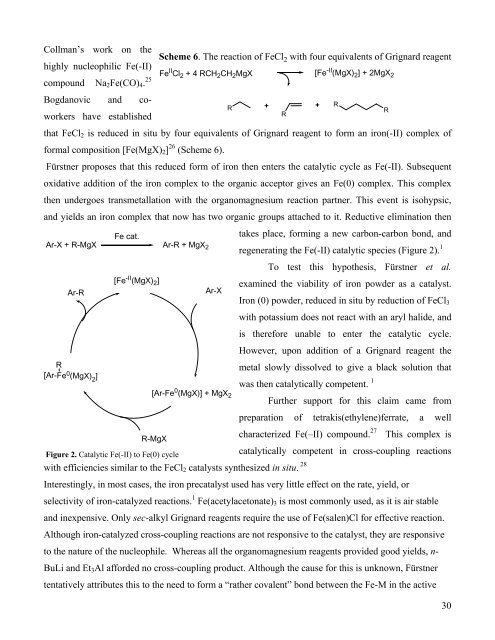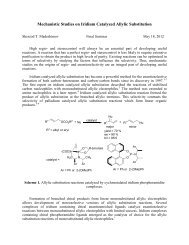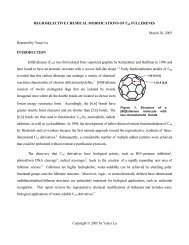Metal-Catalyzed Cross-Coupling Reactions: Entering the Iron
Metal-Catalyzed Cross-Coupling Reactions: Entering the Iron
Metal-Catalyzed Cross-Coupling Reactions: Entering the Iron
You also want an ePaper? Increase the reach of your titles
YUMPU automatically turns print PDFs into web optimized ePapers that Google loves.
Collman’s work on <strong>the</strong><br />
highly nucleophilic Fe(-II)<br />
compound Na2Fe(CO)4. 25<br />
Bogdanovic and co-<br />
workers have established<br />
that FeCl2 is reduced in situ by four equivalents of Grignard reagent to form an iron(-II) complex of<br />
formal composition [Fe(MgX)2] 26 (Scheme 6).<br />
Scheme 6.Thereaction of FeCl 2 with four equivalents of Grignard reagent<br />
Fe II Cl 2 + 4 RCH 2CH 2MgX [Fe -II (MgX) 2] + 2MgX 2<br />
R<br />
Fürstner proposes that this reduced form of iron <strong>the</strong>n enters <strong>the</strong> catalytic cycle as Fe(-II). Subsequent<br />
oxidative addition of <strong>the</strong> iron complex to <strong>the</strong> organic acceptor gives an Fe(0) complex. This complex<br />
<strong>the</strong>n undergoes transmetallation with <strong>the</strong> organomagnesium reaction partner. This event is isohypsic,<br />
and yields an iron complex that now has two organic groups attached to it. Reductive elimination <strong>the</strong>n<br />
Fe cat.<br />
Ar-X + R-MgX Ar-R + MgX2 R<br />
Ar-R<br />
[Ar-Fe 0 (MgX) 2 ]<br />
[Fe -II (MgX) 2]<br />
Ar-X<br />
[Ar-Fe 0 (MgX)] + MgX 2<br />
R<br />
R<br />
takes place, forming a new carbon-carbon bond, and<br />
regenerating <strong>the</strong> Fe(-II) catalytic species (Figure 2). 1<br />
To test this hypo<strong>the</strong>sis, Fürstner et al.<br />
examined <strong>the</strong> viability of iron powder as a catalyst.<br />
<strong>Iron</strong> (0) powder, reduced in situ by reduction of FeCl3<br />
with potassium does not react with an aryl halide, and<br />
is <strong>the</strong>refore unable to enter <strong>the</strong> catalytic cycle.<br />
However, upon addition of a Grignard reagent <strong>the</strong><br />
metal slowly dissolved to give a black solution that<br />
was <strong>the</strong>n catalytically competent. 1<br />
Fur<strong>the</strong>r support for this claim came from<br />
preparation of tetrakis(ethylene)ferrate, a well<br />
characterized Fe(–II) compound. 27 This complex is<br />
catalytically competent in cross-coupling reactions<br />
with efficiencies similar to <strong>the</strong> FeCl2 catalysts syn<strong>the</strong>sized in situ. 28<br />
R-MgX<br />
Figure 2. Catalytic Fe(-II) to Fe(0) cycle<br />
Interestingly, in most cases, <strong>the</strong> iron precatalyst used has very little effect on <strong>the</strong> rate, yield, or<br />
selectivity of iron-catalyzed reactions. 1 Fe(acetylacetonate)3 is most commonly used, as it is air stable<br />
and inexpensive. Only sec-alkyl Grignard reagents require <strong>the</strong> use of Fe(salen)Cl for effective reaction.<br />
Although iron-catalyzed cross-coupling reactions are not responsive to <strong>the</strong> catalyst, <strong>the</strong>y are responsive<br />
to <strong>the</strong> nature of <strong>the</strong> nucleophile. Whereas all <strong>the</strong> organomagnesium reagents provided good yields, n-<br />
BuLi and Et3Al afforded no cross-coupling product. Although <strong>the</strong> cause for this is unknown, Fürstner<br />
tentatively attributes this to <strong>the</strong> need to form a “ra<strong>the</strong>r covalent” bond between <strong>the</strong> Fe-M in <strong>the</strong> active<br />
R<br />
30






